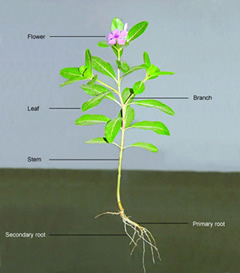Dicot Plant

Dicot Plant angiospermous plant having seeds with two cotyledons and an exogenous manner of growth. The members constitute a natural group of closed seeded flowering plants. It is one of the classes of the great subdivision of flowering plants, the Angiosperms. Dicotyledonous plants are also called Magnoliopsida. The radical after germination is generally persistent and produces taproot. Stems with vascular elements are arranged either in a hollow cylinder around the relatively small pith or in bundles arranged in a single circle when observed in cross section. The leaves typically have netted venation of the palmate or pinnate type.
The flowers are pentamerous. Dicot plants are now the most successful and dominant plant group. About 4,00,000 species of angiospermic plants have so far been recorded of which more than 2,50,000 are dicotyledons (the remaining are monocotyledons). Almost all the trees that are commonly found in Bangladesh and other tropical and subtropical regions of the world are Dicotyledonous plants (except palms and bamboo, which are monocots). Except cereals almost all fruits, vegetables, pulses, timber, tannins, beverages, and spices, and thousands of other plant products come from the Dicot plants. Bangladesh is endowed with about 5,000 species of flowering plants of which more than two third are dicotyledonous. Dicot plants dominate the forests, village groves and woodlands of Bangladesh. [Mostafa Kamal Pasha]
